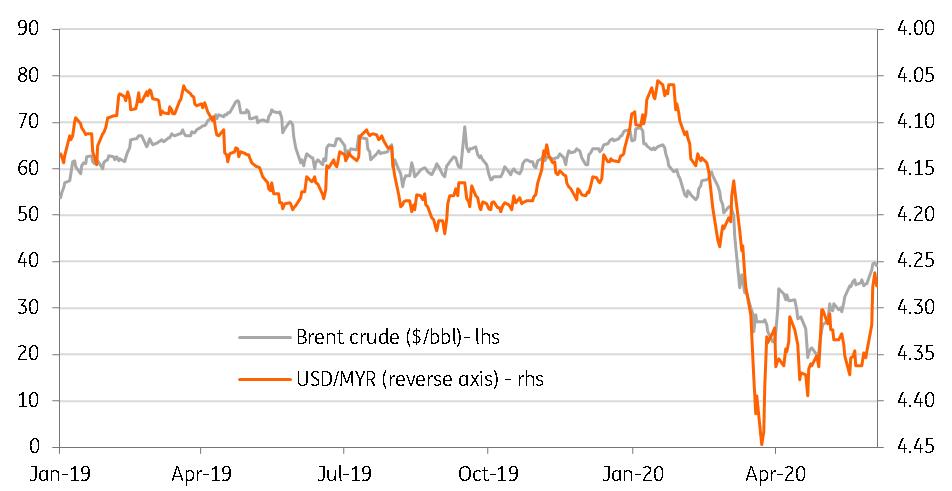Malaysia’s export resilience comes to an end
A sharp fall in exports and the widest ever trade deficit suggests the recent relief for the Malaysian ringgit from improving oil prices may not last
| 23.8% |
Export fall in AprilYear-on-year |
| Worse than expected | |
Electronics and oil dent exports
The resiliency of Malaysian exports seen earlier this year has ended.
23.8% year-on-year export plunge in April was steeper than our -19.0% estimate and consensus of -12.8%. This follows -4.7% YoY growth in March. Just like some of its Southeast neighbours’ Malaysian exports held their ground in the first quarter with 1.1% growth but not anymore.
Electrical and electronics - the dominant of all product groups with 38% weight in total exports, remained the main drag with the accelerated decline (-22% YoY vs. -14% in March). And, as we expected, oil and petroleum products exports followed in (-23% vs. +14%), led by a double whammy of global demand slump and low prices.
In terms of destinations, the US and Japan were the weak spots with 31% and 28% fall in shipments, respectively. Bucking the trend, was China with a 4% rise in exports, as a hopeful sign of post-Covid recovery of demand in the biggest export market.
Record trade deficit
Imports also contracted by 8% YoY, though not as bad as consensus expectations of -15.6%. Most product categories posted steeper import falls than in the preceding month, though, oddly enough, transport equipment outshined with 233% jump.
Narrowing trade surplus and weak tourism revenues due to Covid-19 are likely to cause a dent to the current account surplus this year
This produced a trade deficit of MYR 3.5 billion - the highest deficit ever following a surplus of over MYR 12 billion in March. The year-to-date trade balance is still in surplus at MYR 33.4 billion, though that's a sharp narrowing from MYR 48 billion surplus in the same period last year.
Narrowing trade surplus and weak tourism revenues due to Covid-19 are likely to cause a dent to the current account surplus this year.
We anticipate it to be equivalent to 1.5% of GDP as against 3.4% in 2019.
Not good for the currency
The recent pick up in oil prices has been a relief for the ringgit, helping the recovery from a sharp depreciation to 4.45 in March to 4.28 currently.
However, the trade figures suggest that the relief may not last for long. Besides ongoing weak economic fundaments, continued political risk remains a key headwind for future MYR appreciation.
We continue to see the USD/MYR trading above 4.40 over the next three months.
Oil drives MYR

Download
Download article
5 June 2020
Good MornING Asia - 5 June 2020 This bundle contains {bundle_entries}{/bundle_entries} articles"THINK Outside" is a collection of specially commissioned content from third-party sources, such as economic think-tanks and academic institutions, that ING deems reliable and from non-research departments within ING. ING Bank N.V. ("ING") uses these sources to expand the range of opinions you can find on the THINK website. Some of these sources are not the property of or managed by ING, and therefore ING cannot always guarantee the correctness, completeness, actuality and quality of such sources, nor the availability at any given time of the data and information provided, and ING cannot accept any liability in this respect, insofar as this is permissible pursuant to the applicable laws and regulations.
This publication does not necessarily reflect the ING house view. This publication has been prepared solely for information purposes without regard to any particular user's investment objectives, financial situation, or means. The information in the publication is not an investment recommendation and it is not investment, legal or tax advice or an offer or solicitation to purchase or sell any financial instrument. Reasonable care has been taken to ensure that this publication is not untrue or misleading when published, but ING does not represent that it is accurate or complete. ING does not accept any liability for any direct, indirect or consequential loss arising from any use of this publication. Unless otherwise stated, any views, forecasts, or estimates are solely those of the author(s), as of the date of the publication and are subject to change without notice.
The distribution of this publication may be restricted by law or regulation in different jurisdictions and persons into whose possession this publication comes should inform themselves about, and observe, such restrictions.
Copyright and database rights protection exists in this report and it may not be reproduced, distributed or published by any person for any purpose without the prior express consent of ING. All rights are reserved.
ING Bank N.V. is authorised by the Dutch Central Bank and supervised by the European Central Bank (ECB), the Dutch Central Bank (DNB) and the Dutch Authority for the Financial Markets (AFM). ING Bank N.V. is incorporated in the Netherlands (Trade Register no. 33031431 Amsterdam).